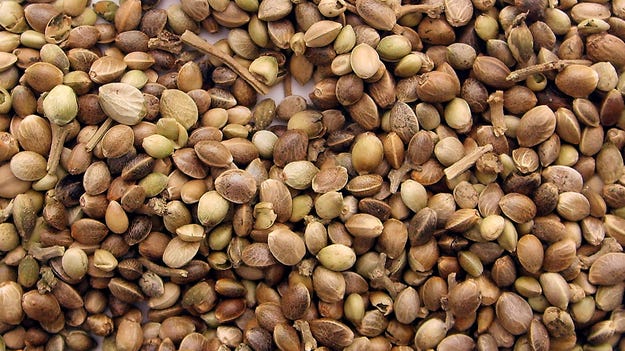How do I choose marijuana seeds?

How to chose the right marijuana seeds for your garden
Growing season is upon us in North America, and as the final rains of winter taper off, it’s time to put plants in the ground. With legalization in California and seven other states as well as Washington D.C., more folks than ever will want to try out their special green thumb. But many are just starting out, and one of the first questions you need to answer is ‘how do I choose cannabis seeds?’
Type of High: Well, what type of effect do you want?
Consumers are usually given a choice between Indica and Sativa-dominant strains, even though most marijuana on the market today has been hybridized, or crossbred, to some degree. Typically, indica strains tend to be associated with body relaxation, while sativa strains tend to be associated with a mind high. Marijuana’s effects may vary from person to person. Choose the high that is right for you based on samples of dried flower bud you like. Maybe it’s Blue Dream for you, and Jack Herer for the spouse.
Difficulty: How good are you at growing?
If you can grow good tomatoes, than you can probably grow good marijuana. This is because many of the environmental conditions necessary for healthy tomato growth are generally consistent with healthy marijuana growth. But different strains have different levels of tolerance for less than perfect conditions. Some strains like Blueberry from DJ Short are very easy and fun to grow. Other strains like Cookies can require more dialed-in nutrients and attention to get the best results. Start with a super-easy-to-grow strain.
Height: How much room do you have?
Starting from a small seedling, a plant will grow to be around 6’ to 8’ tall during a regular growing season if the root system allows. Chose seeds that fit your growing space. Plant size is determined by several key factors, including; genetics, root size, pruning and training. Generally, sativa plants tend to be taller, with long heavy buds. Indica plants tend to be shorter and bushier with large, pinecone shaped buds. Ultimately, the size of your plant has to do with the size of its root system – which is restricted by the limits of your growing medium. Plants can also be pruned for shape and height. If vertical space is an issue, plants can be trained to grow a certain direction, such as horizontally, by using netting techniques to hold them down, keeping them from their natural tendency to grow vertically.
Climate: Are you going indoors or out?
Plants are meant to be grown outdoors, the way nature intended. However, some growers prefer to grow indoors as more marijuana can be yielded per square foot of canopy space in a year-round, climate-controlled environment, when compared to a once or twice seasonal outdoor harvest of the same canopy space. Indoor grows typically require a substantial investment in terms of climate controls, energy costs and plant maintenance to be productive. Outdoor growers need to be mindful of the specific micro-climate of their location, to include proximity to neighbors and the privacy of your growing area. Total hours of sunlight, valleys, hillsides, shade, open, wind, rainfall, etc. are all variables to consider in addition to the mean temperature of your geographic region. All these factors play into which seeds you chose. Pick seeds that are adapted to your growing conditions. Any cannabis seed could be grown indoors or out, but many strains do better in one or the other.
Flowering: How much time do you have?
The length of your growing season needs to be considered when determining the “finish time” on your flowering marijuana plant. Some plants can be ready to harvest within eight weeks of flowering, while some plants can take 12-14 weeks or longer. You’ll want to choose seeds that finish within the time you have allotted for the season indoors or out. Mostly this is a concern with long-flowering sativas, some of which refuse to finish before winter starts.
Sexing: Should I all-natural or go feminized?
Marijuana has male and female sexes, just like humans. When you buy seeds, you generally get an unknown mix of male and females. You’ll want to kill the males and grow out the females – as unfertilized female flower buds are the most potent. Sexing is fun. When you sprout a seed, not knowing if it will be a precious female flower or a pollen sack hung male, there is a certain feeling of excitement while waiting for the plant to sex. Sex can be determined usually within about a week after inducing flowering, with the naked eye. Though, nowadays there’s mail-in sex tests you can perform for about $100 for 10 tests. Male plants pollinate females to produce seeds. Therefore, all plants should be quarantined until the sex is determined to avoid accidental pollination of females. Male plants are typically destroyed to avoid pollination.
While sexing can lend itself to completely all-natural gardening, sometimes it is easier and more productive to start with a feminized seed. Feminized seeds are chemically treated to change genes and guarantee a seed will sprout a female plant. The problem is, the chemicals weaken and destabilize the genetics and prevent you from using that feminized plant to make new seeds. All seeds from a feminized plant will be female.
[GreenState cultivation columnist Kevin Oliver is the co-author of “Idiot’s Guides: Growing Marijuana” (Alpha, 2016). Oliver is also the Founder/CSO, of Washington’s Finest Cannabis (A WSLCB Licensed Marijuana Business). Oliver is on the Board of Directors for NORML, the Executive Director of WANORML/WANORML PAC — The Washington Affiliate of the National Organization for the Reform of Marijuana Laws.]